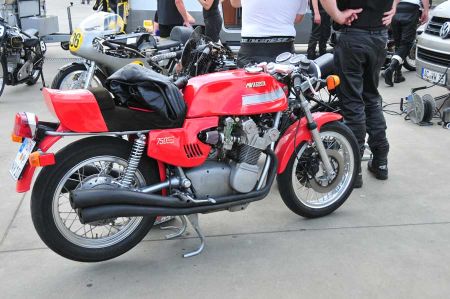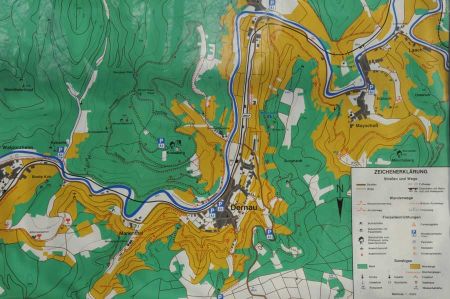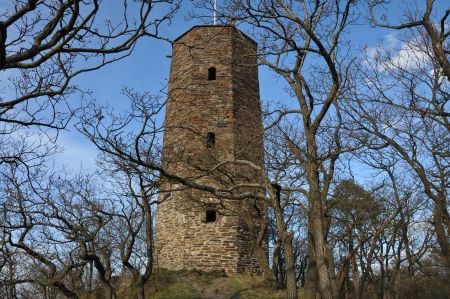We have been friends with Frank and his wife for a number of years, who, in addition to the vineyards, also run a small guesthouse in Dernau and have been producing really fine wine in Turkey for several years with great success.
That's why a visit to the wine village of Dernau has been on our itinerary several times, but there was always a lack of time. Dernau is a small town in the district of Ahrweiler in the north of Rhineland-Palatinate, which we have only known about while driving through the Museum of the Roman Villa in Ahrweiler, which really inspires us, on the way to the Nürburg Ring.
A detour to the Nürburgring racetrack
 Early Thursday morning we start the journey in the direction of Dernau, past Frankfurt, through the Rhine Valley to Koblenz, where we then head in the direction of Ahrweiler. Surprisingly, there is little traffic on the roads, so we arrive in Dernau well before the agreed time. And as so often, we use the time to explore the area a little more closely. The drive through the Ahr Valley alone is an experience: small, idyllic wine villages along the banks of the Ahr, beautifully situated campsites and an awakening spring landscape that invites you to go hiking or cycling. Of course, the nearby Nordschleife of the Nürburg Ring is also extremely attractive for those who used to be enthusiastic motor sports enthusiasts themselves, especially as it is only 35 kilometres to the racetrack.
Early Thursday morning we start the journey in the direction of Dernau, past Frankfurt, through the Rhine Valley to Koblenz, where we then head in the direction of Ahrweiler. Surprisingly, there is little traffic on the roads, so we arrive in Dernau well before the agreed time. And as so often, we use the time to explore the area a little more closely. The drive through the Ahr Valley alone is an experience: small, idyllic wine villages along the banks of the Ahr, beautifully situated campsites and an awakening spring landscape that invites you to go hiking or cycling. Of course, the nearby Nordschleife of the Nürburg Ring is also extremely attractive for those who used to be enthusiastic motor sports enthusiasts themselves, especially as it is only 35 kilometres to the racetrack.
We use the 267-country road to Altenahr, then the 257 to Adenau, where we make a short stop in the parking lot at the second entrance to the Nordschleife to take a look at this notorious racetrack. Coming from the Quiddelbacher Höhe, the route of the Nordschleife runs as a bridge over the country road. And as always, there is a lot of activity on the Nordschleife and at the parking lot of the access road. One can only hope that despite the quarrels about the Nürburgring AG known from the media, this historic “Green Hell” track will be preserved. We quickly get involved in conversations with other visitors and are also made aware of some "Erlkönigen" who are on test drives on the Nordschleife. We will also report separately on that and on the visit to the Nürburg.
The red wine hiking trail - a tourist highlight
 Slowly it was time to drive back to Dernau, because the agreed time for our meeting was approaching. Frank is already waiting for us in front of the house and a coffee is already ready on the table, along with a piece of cake, what more could the dear soul want. We are quickly immersed in the exchange of experiences and events of the last few months and time flies. Frank has planned a small picnic on Dernau's local mountain, so that we can make our way to the Krausberg in the late afternoon. In addition to a lookout tower made of natural stone, there is a small restaurant that is run up here by a privately organized association. A popular local recreation destination for the local population with a wonderful view of the Ahr Valley and Dernau in particular. The location can be rented for events, so that private celebrations often take place. Hiking trails are indicated on a display board, which lead along the slopes of the Ahr Valley through the vineyards. Of course, these paths are particularly easy to see from up here. A very special path is the so-called red wine hiking trail, which is probably one of the most beautiful and well-known hiking trails in Germany. The red wine hiking trail always follows the Ahr over a distance of approx. 30 kilometres along a varied hiking route with different levels of difficulty. One recommendation is to take part in the so-called Dernau Spring, since many winegrowers have opened their doors next to the hiking trails or set up stands along the hiking route. Thus, the physical well-being is always taken care of during the hike. We're now ending our first exploration of Dernau's surroundings, because it's getting noticeably cool up here on the Krausberg.
Slowly it was time to drive back to Dernau, because the agreed time for our meeting was approaching. Frank is already waiting for us in front of the house and a coffee is already ready on the table, along with a piece of cake, what more could the dear soul want. We are quickly immersed in the exchange of experiences and events of the last few months and time flies. Frank has planned a small picnic on Dernau's local mountain, so that we can make our way to the Krausberg in the late afternoon. In addition to a lookout tower made of natural stone, there is a small restaurant that is run up here by a privately organized association. A popular local recreation destination for the local population with a wonderful view of the Ahr Valley and Dernau in particular. The location can be rented for events, so that private celebrations often take place. Hiking trails are indicated on a display board, which lead along the slopes of the Ahr Valley through the vineyards. Of course, these paths are particularly easy to see from up here. A very special path is the so-called red wine hiking trail, which is probably one of the most beautiful and well-known hiking trails in Germany. The red wine hiking trail always follows the Ahr over a distance of approx. 30 kilometres along a varied hiking route with different levels of difficulty. One recommendation is to take part in the so-called Dernau Spring, since many winegrowers have opened their doors next to the hiking trails or set up stands along the hiking route. Thus, the physical well-being is always taken care of during the hike. We're now ending our first exploration of Dernau's surroundings, because it's getting noticeably cool up here on the Krausberg.
A striking goal - Roman villa in Ahrweiler
In the evening we sit together for a while and learn a few details about the community itself. The discovery of the Roman villa in Ahrweiler already indicates that the Ahr Valley was also settled by the Romans. In 1884, when work was being carried out to found the cellars of the Dernau Winegrowers' Association, parts of a Roman courtyard were also found here, which had a hot water supply, bathing facilities and a burial ground. This villa rustica was once comparable in size to the farm site excavated in Ahrweiler, at least as indicated by mosaics and coin finds from the 3rd and 4th centuries.
After the collapse of the Roman era, the Franks first settled in the Ahr valley. Two medieval castles, the ruins of which are said to have been visible until the 1950s, were built by the Ripuarians here. The plots "Im Graben" and "An der Burg" still point to this today.
Historical background of Dernau and surroundings
Until around 843, the region around Dernau belonged to the Franconian Carolingian Empire, the division of which became known due to the decisions of the Treaty of Verdun by Lothar I, ruler of the so-called Middle Kingdom and eponym of the later Lorraine region. Only 12 years later, Lothar I again divided his imperial territory, which bordered Friesland via the Rhine Valley to the Mediterranean Sea, among his descendants.
In 1588 Dernau was plundered by the troops and lansquenets of Martin Schenk von Nideggen, during the Thirty Years' War the Saffenburg was the scene of witch trials several times, which could only be ended with the occupation by the Swedes in 1632 after the witch hunters had been driven out. Again Dernau, Mayschoß and Rech were plundered by the troops. To prevent further occupations of the Saffenburg by mercenary troops, the Duke of Jülich had the Saffenburg destroyed in 1704.
Despite an initially strict policy of secrecy, Dernau repeatedly appeared in the headlines of the press in the 1960s: the mysterious government bunker was built between Ahrweiler and Dernau under the code name "Dienststelle Marienthal". A total of 12 years of work was done on this building, which was intended to serve as an alternative government seat for the then constitutional organs of the Federal Republic of Germany in the event of defense. With the end of the Cold War and the move of the federal government to Berlin, the strategic importance of the government bunker was over. Today, a small part of the bunker serves as a museum, which opened on September 1, 2008. How immense the bunker system actually was can only be guessed at from the various entrance portals. The bunker museum is always worth a visit.
Let's go to the red wine hiking trail
After a hearty breakfast the next morning, Frank invites us to take a short walk along the red wine trail, which takes us out of the center of Dernau and onto the terraced slopes and paths of the vineyards. Now it also becomes clear how arduous winegrowing in the Ahrteil must really be, the slopes are so steep and the grafting structures of the vines are so different. Sometimes the vines are pruned very short and only one shoot is attached to the man-made support system, sometimes there are multiple shoots. Then again the shoots are bound almost in a circle, then again the vine is very tall and shows a multitude of shoots. It is a very interesting walk along the so different cultivation methods and varieties with such comprehensive new insights that were simply unknown to us until now. Of course, we will not immediately become wine connoisseurs with this first walk, but at least it will become clear what a great influence the slope and cultivation method will have on the quality of the wines.
The Marienthal Monastery - a ruined monastery church
We leave the vineyards via the path marked Klosterstraße, because Frank has another sight that he would like to introduce to us: Marienthal Monastery. Founded around 1136, plundered by Swedish troops in 1632 and burned down by Turenne's troops in 1646, then completely rebuilt in 1699, the monastery was abolished under Napoleon during the secularization of 1802. Today a modern restaurant and wine production facility, the facility serves as a local recreation destination with a very special highlight: the ruins of the monastery church. Only the enclosing walls of the church are still standing, but concerts and other cultural events take place here several times a year. Probably the best-known German jazz rocker, Klaus Doldinger, has already made a guest appearance in the monastery church ruins. We take the opportunity to visit and end the tour in the beautiful monastery courtyard with a glass of wine. Of course, during the conversation that follows, some interesting perspectives regarding future events here on site also emerge. The once state-run winery was taken over by local private winegrowers in 2004 and expanded further.
We end our tour of Dernau a little later at one of Frank's friend's winemaker, who also takes us to his "wine treasury". Once a year, the two wine experts travel somewhere in the world to exchange ideas with other wine producers as part of a concept that combines training and relaxation. During these trips, real rarities are sometimes bought and added to the collection in Dernau in addition to a lot of experience and information. We also learn here that the winemaker also keeps special wines as leftover stock for special occasions and no longer sells them, despite interesting offers. An interesting and informative day in Dernau is coming to an end.
Please read as well:
Ahrtal - wine route and red wine hiking trail
Villa Rusticae in Bad Neuenahr - Ahrweiler

